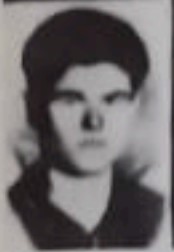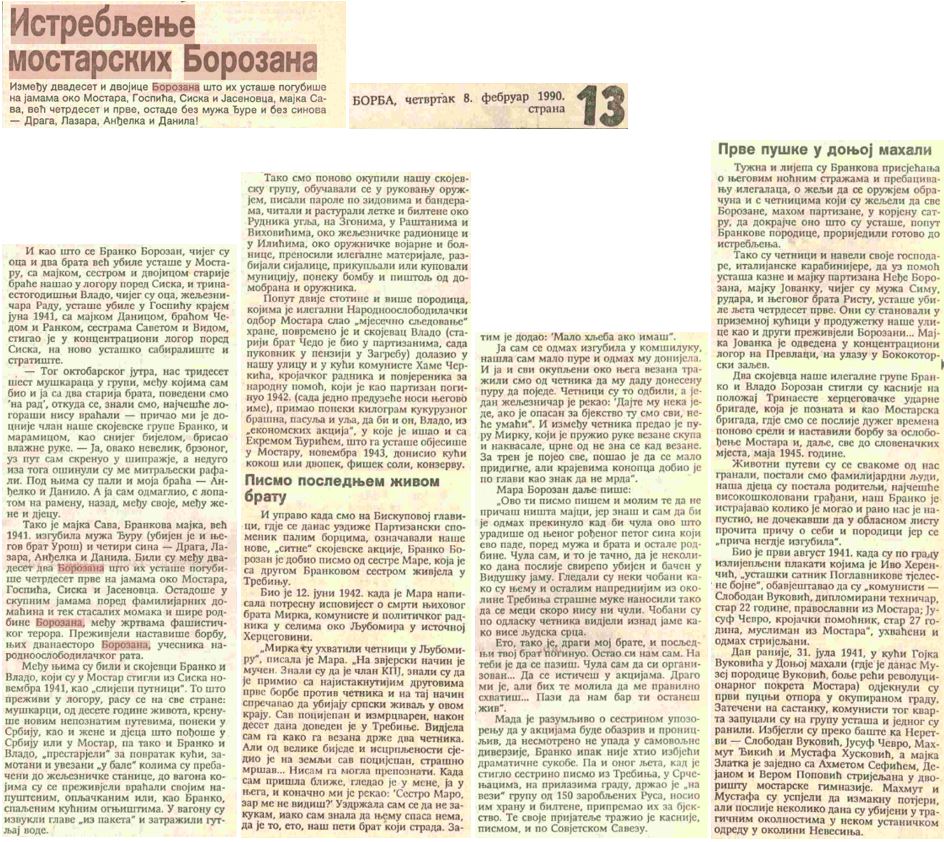
brochure "Partizanski spomenik u Mostaru" (1980)
book “Spomenica Mostara 1941-1945.”
another document or proof of the memorial stone (e.g., a photograph).
Mirko Đ. BOROZAN
MIRKO BOROZAN, son of ĐURO, born on January 20, 1921, in Vihovići near Mostar. Carpenter, pre-war member of the Communist Party of Yugoslavia (KPJ). Prior to the war, he lived in Trebinje. Joined the National Liberation War (NOV) and Partisan Detachments of Yugoslavia (POJ) in 1941. Communist, political worker in the eastern Herzegovina region in villages around Ljubomir. Fighter, political commissar of the unit in the Ljubomir Partisan Detachment. Captured in a Chetnik coup near Trebinje and killed on July 11, 1942, thrown into the Vidaška Pit in the village of Morče, near Bileća.
EXCERPT FROM LITERATURE:
Mensur Seferović described Mirko’s death in the book “Mostarski kolopleti”, based on letters from sister Mara to their other brother Branko:
“It was June 12, 1942, when Mara wrote a heartbreaking account of the death of their brother Mirko, a communist and political worker in the villages around Ljubomir in eastern Herzegovina. ‘Mirko was captured by the Chetniks in Ljubomir,’ wrote Mara. ‘He was brutally tortured. They knew he was a member of the KPJ, they knew that he fought the first battles against the Chetniks alongside the most prominent comrades, preventing them from killing the Serbian population in this region. All torn and battered, after ten days, he was brought to Trebinje. I saw him being held by two tied-up Chetniks, but due to extreme misery and exhaustion, he was sitting on the ground, all torn apart, terribly thin… I couldn’t recognize him. When I approached closer, he looked at me, I at him, and finally, he said: “Sister Mara, don’t you see me?” I held back from crying, although I knew there was no salvation for him, that he was our fifth brother who perished. Then he added: ‘If you have any bread, please give it to me.’ I immediately disappeared into the neighborhood, found a bit of poultry, and brought it to him. Both I and everyone gathered around him, tied up as we were, pleaded with the Chetniks to let him eat the poultry we brought. The Chetniks refused, but one railroad worker said: ‘Give it to him, let him eat it. If he poses a danger of escape, we are all here, he won’t escape.’ And between the Chetniks, he handed the poultry to Mirko, who stretched out his tied and damp black hands, tied up who knows when. In an instant, he ate everything, he stood up to regain his strength, but he was struck on the head with the ends of a rope as a sign not to move.'”
Mara Borozan continues:
“I am writing you this letter and please don’t tell anything to our mother because you know that it would devastate her if she heard what they did to her own fifth son who, as you know, fell alongside her husband and brother and other relatives. I heard, and it’s true, that a few days later he was brutally killed and thrown into the Vidaška Pit. Some shepherds witnessed the dreadful torments inflicted upon him and the other progressive individuals from the surroundings of Trebinje, to the extent that the shots were barely heard. After the Chetniks left, the shepherds saw several pits with human hearts hanging. So, dear brother, this is how it happened, and our last remaining brother perished. You are the only one left for us. It’s up to you to take care of yourself… I’ve heard that you are organized… That you stand out in actions. I’m glad, but I would kindly ask you to understand me correctly… Be careful to at least stay alive for us. The Russians have begun their tactics and plan, freedom is almost here.”
Seferović, Mensur: Mostarski kolopleti, edicija “Mostar u borbi za slobodu”, knjiga 8, Mostar; grupa autora: “Spomenica Mostara 1941-1945.”; grupa autora (1961): Hercegovina u NOB 1. dio, Beograd, Vojno delo; grupa autora (1986): Hercegovina u NOB 4. dio, Beograd
Photo of the memorial plaque: S. Demirović (2018), photo of the fighter: “Partizanski spomenik u Mostaru” (1980)
Do you have more information about this fighter? Share your stories and photographs. Let's keep the memory alive!


